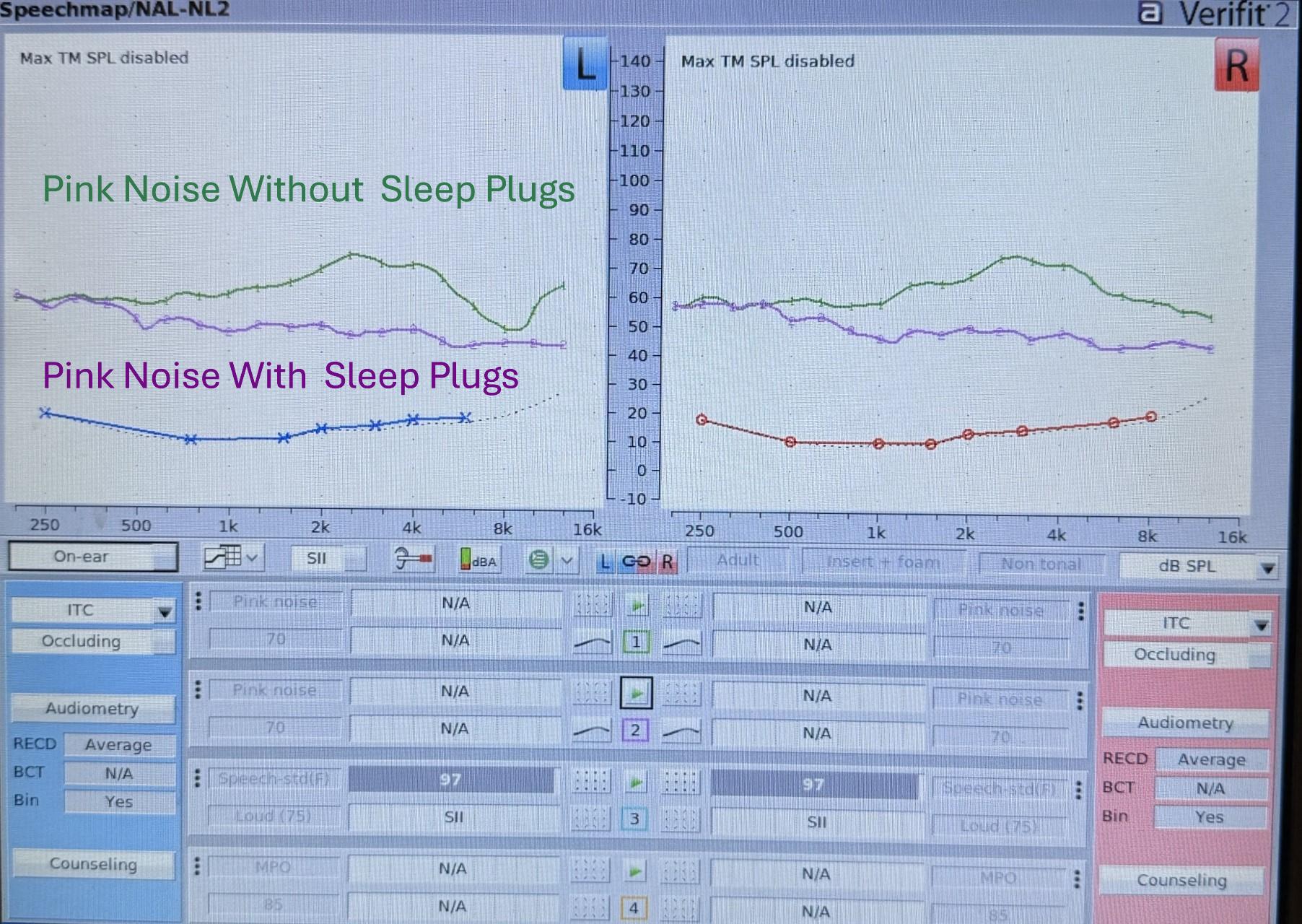Custom Sleeping Earplugs
Starkey Hearing custom sleeping earplugs are made of a soft, comfortable material, these earplugs are designed to reduce ambient noise and improve sleep quality. Inspired to assess their performance, I embarked on a mission to test their effectiveness.
Objective Measures
First in line was using a device called the Audioscan Verifit 2. While this equipment is primarily designed to verify hearing aids, it can also measure the attenuation characteristics of custom earplugs. I played a 75 dB pink noise stimulus and measured the sound levels both without the earplugs and with them in place.

The results were plotted on a graph, where the x-axis represents frequency (in Hz), and the y-axis represents sound level (in dB SPL). The green line indicates the output of the pink noise without the earplugs, while the purple line represents the attenuation achieved with the earplugs.

To make the results more accessible, I summarized the data in a table. The attenuation ranged from 1 dB at 250 Hz to 25 dB at 3000 Hz, with the greatest reduction occurring in the 2-6 kHz range. Interestingly, while snoring is most prominent in the 100 to 300 Hz range, the earplugs provided limited attenuation at those lower frequencies.
Subjective Measures
Next, we obtained subjective data by testing the hearing thresholds in the sound booth. Using an audiogram, I first recorded the hearing thresholds without the earplugs.
An audiogram is a visual representation of a person’s hearing ability. It charts the softest sounds a person can hear at different frequencies (measured in Hertz, Hz) and intensities (measured in decibels, dB). The horizontal axis represents frequency, ranging from low-pitched to high-pitched sounds, while the vertical axis indicates intensity, with softer sounds at the top and louder sounds at the bottom. Each ear is tested separately, with results for the right ear shown as circles and the left ear as Xs.

I then repeated the test with the custom earplugs in place. The results revealed attenuation ranging from 25 dB at 250 Hz to 50 dB at 8000 Hz, demonstrating significant sound reduction, particularly at higher frequencies.
Conclusion
By combining objective and subjective measures, I was able to comprehensively evaluate the performance of the custom sleeping earplugs. This analysis confirms that the earplugs offer substantial noise attenuation across a wide frequency range, making them a valuable solution for reducing nighttime disturbances and improving sleep quality.
Final Note on Tinnitus and Misophonia
Custom sleeping earplugs are not something I typically recommend for my patients with tinnitus. However, for individuals with misophonia, they may offer significant benefits. Ambient sounds such as cars, voices, barking dogs, or music can trigger a fight-or-flight response in some individuals with misophonia, making custom sleeping earplugs a useful tool for managing these triggers at night.
Custom earplugs can also be paired with a bedside sound generator to provide additional relief by masking disruptive sounds. Another option I often recommend is the Ozlo Sleepbuds, which were developed by former Bose engineers. My wife owned a pair of the original Bose Sleepbuds and absolutely loved them, finding them both comfortable and effective for promoting restful sleep.

Dr. Jon Douglas specializes in tinnitus, hyperacusis & misophonia management, hearing aid technology, and vestibular evaluations. With over 19 years of academic and clinical experience, Dr. Douglas is deeply committed to providing evidence-based audiological care that improves the lives of patients affected by hearing, balance, and sound sensitivity disorders.
